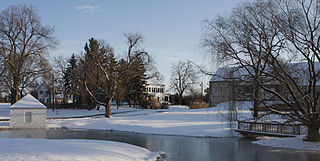
The Nallin Farm House and the related Nallin Farm Springhouse and Bank Barn are located on Fort Detrick at Frederick, Maryland.

The Nallin Farm Springhouse and Bank Barn are closely associated with the Nallin Farm House on the grounds of Fort Detrick, Maryland, US. The barn is a good example of a fieldstone-built bank barn with a byre on the lower level and an earth ramp on the opposite side providing access to a haymow.
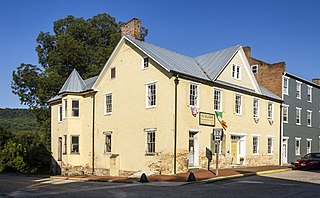
The Burkittsville Historic District comprises the small town of Burkittsville, Maryland. Located at a crossroads in western Frederick County, the town is a consistent collection of early 19th-century Federal style houses mixed with a few Victorian style houses that has remained virtually unchanged since 1900. The town is surrounded on three sides by an open, farmed landscape, and nestles against South Mountain on its western side.
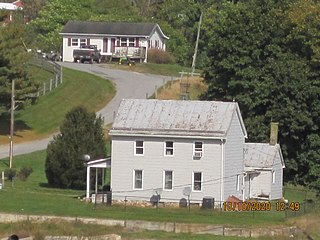
The Drummine Farm is a historic home and farm complex located at New Market, Frederick County, Maryland, United States. The main house was constructed about 1790 and is a 2+1⁄2-story structure of uncoursed fieldstone. The house retains Georgian stylistic influences in exterior and interior decorative detailing. The farm complex structures include a stone tenant house dated 1816, and four additional fieldstone buildings from the early 19th century: a smokehouse, a water storage house, a garden outhouse, and a large bank barn. Wooden farm buildings include a calf shed and a wagon shed with corn cribs from the late 19th century, a dairy barn with three cement stave silos from the 1930s, several sheds and garages, and a large pole barn.
The Daniel Sheffer Farm is a historic home and farm complex located at Middletown, Frederick County, Maryland, United States. It is dominated by the two story brick main house, which was constructed between 1840 and 1850. Outbuildings include a stone spring house, a large wood-frame barn, constructed about 1900, and several wood-frame outbuildings including a corncrib, a wagon shed, three frame wood sheds, two tractor sheds, and a chicken house. A concrete block milk house and terra cotta silo were added to the complex in the 1930s. In September 1862, the property served as a temporary hospital for wounded soldiers during the Battle of South Mountain in the American Civil War.
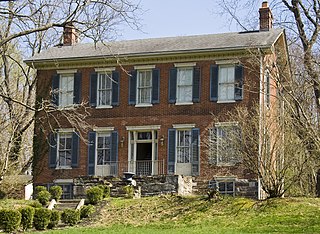
The Linganore Farm is a historic home and farm complex located at Frederick, Frederick County, Maryland, United States. The main house is a large two-story brick dwelling dating from the 1850s-60s and showing influence of the Greek Revival and Italianate styles. The property includes the ruins of a brick smokehouse, a stone root cellar and a two-story brick secondary house dating from the early 19th century. Across from the house is the site of the Linganore Mill, which was located on the east bank of the Monocacy River. In front of the house is a terraced lawn defined with large boxwoods. In 1891, the farm was converted to a resort known as the Linganore Hills Inn.
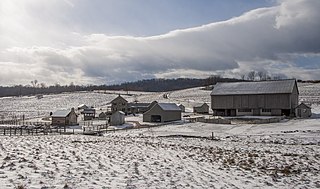
Peter of P. Grossnickel Farm is a historic home and farm complex located at Myersville, Maryland, Frederick County. It consists of a mid-19th-century, Greek Revival farmhouse and 13 related buildings and structures. The house is a 2+1⁄2-story stone center-passage house on a limestone foundation, with a 1+1⁄2-story kitchen wing and 18-inch-thick (460 mm) walls. The house was built between 1840 and 1850. Also on the property is an 1881 tenant house with corresponding barn, spring house, and washhouse / privy; an 1884–1897 bank barn; a pre-1830 granary; a 19th-century wood shed; late-19th-century hog pen / chicken house; a pre-1830 beehive oven; a late-19th-century smokehouse; a spring house with a Late Victorian cottage addition; and early-20th-century concrete block milk house; and a log summer kitchen of unknown date. The Grossnickel family was a German American family who were instrumental in the establishment of the Grossnickel Church of the Brethren.

Harris Farm is a historic home and farm complex located at Walkersville, Frederick County, Maryland, United States. The main house was built in 1855, and is a three-story center plan house in predominantly late Greek Revival syle, with some Italianate elements. The agricultural complex consists of a bank barn with an attached granary; a second frame barn that shares an animal yard with the bank barn; a row of frame outbuildings including a converted garage, a workshop, and a chicken house. There is also a drive-through double corn crib; and a frame pig pen from 1914. The 20th-century buildings consist of a frame poultry house, a dairy barn with milk house and two silos, and an octagonal chicken coop. A lime kiln is located on the edge of the property. The property is preserved as part of the Walkersville Heritage Farm Park.
Kitterman–Buckey Farm is a historic home and farm complex located at Johnsville, Frederick County, Maryland. It is the remnant of the farm that was established by the German immigrant Christopher Kitterman in 1752, and which remained in the Root/Buckey family from 1790 to 1919. The main house was built about 1752 and is two stories in height. It is composed of two halves, built probably 40 to 50 years apart, and united under a low-sloping slate roof with three chimneys, with additions made in the 19th century and again in the 1950s and 1980s. Also on the property are a springhouse and cabin / smokehouse both dating to about 1752, a machine shed, horse barn built about 1930, a bank barn built about 1850, and a silo from 1934.
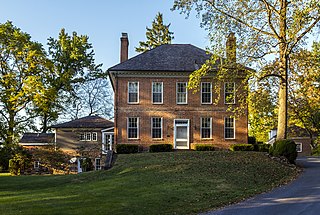
Woods Mill Farm is a historic home and farm complex located at Woodsboro, Frederick County, Maryland. It includes the Colonel Joseph Wood House and associated buildings. The house is an unusual example of an 18th-century brick, Georgian style manor house, built about 1770. It is a two-story brick dwelling with a hipped roof and inside end chimneys. The property also includes two distinctive outbuildings: a two-story, two-room stone and brick smokehouse with a gable roof and a brick end barn built about 1830. The original owner of this property was Col. Joseph Wood, founder of Woodsberry.
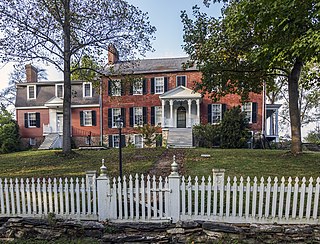
Hopewell is a set of historic homes and farm complexes located at Union Bridge, Carroll County, Maryland, United States. It consists of four related groupings of 19th century farm buildings. The Hopewell complex consists of two historic farms: Hopewell and the smaller F.R. Shriner Farm.

Hoffman Farm is a historic farm complex located at Keedysville, Washington County, Maryland, United States. It consists of an 1840s Greek Revival style two-story brick dwelling, adjacent brick slave quarters, a Federal-style stone house built about 1810 over a spring, a frame wagon shed, a log hog barn, and a frame forebay bank barn. The farm buildings were used as a hospital during the American Civil War in Battle of Antietam from the day of the battle on September 17, 1862, and through the following month. Over 800 men were hospitalized in the barn, house, outbuildings, and grounds.

Gladden Farm, also known as Gladden-Roming Stone House, is a historic home and farm complex located in Street, Maryland. The complex includes three historically-significant structures: a large five-bay rubblestone bank house with Federal detailing, a one-story rubblestone spring house, and a one-story board-and-batten frame shop.

The Bennett-Kelly Farm is an historic home and farm complex located at Sykesville, Carroll County, Maryland, United States. The complex consists of a stone and frame house, a stone mounting block, a stone smokehouse, a frame bank barn, a frame wagon shed, a frame chicken house, a concrete block dairy or tool shed, and a stone spring house. The original mid-19th century stone section of the house is three bays wide and two stories high. The house features a one-bay Greek Revival pedimented portico with Doric columns. It is an example of a type of family farmstead that characterized rural agricultural Carroll County from the mid 19th century through the early 20th century.

Wilson's Inheritance is a historic home and farm complex located at Union Bridge, Carroll County, Maryland, United States. The complex includes the 1832-38 farmhouse, a bank barn, blacksmith shop, washhouse, smokehouse, chicken houses, sheds, and a privy. The brick house features an "L"-shaped plan, stone foundation, gable roof, ornamentation, and its siting into a slope.
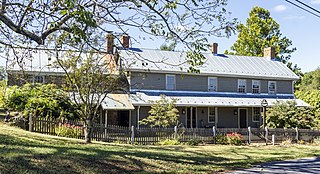
The McMurray–Frizzell–Aldridge Farm is a historic home and farm complex located at Westminster, Carroll County, Maryland, United States. It consists of a log house constructed about 1790 and later enlarged, and several 19th and early 20th century domestic and agricultural outbuildings, including a stone summer kitchen, a frame smokehouse, a frame bank barn, a frame wagon shed, a frame hog pen, and a stone spring house.

Carroll County Almshouse and Farm, also known as the Carroll County Farm Museum, is a historic farm complex located at Westminster, Carroll County, Maryland. It consists of a complex of 15 buildings including the main house and dependencies. The 30-room brick main house was originally designed and constructed for use as the county almshouse. It is a long, three-story, rectangular structure, nine bays wide at the first- and second-floor levels of both front and rear façades. It features a simple frame cupola sheltering a farm bell. A separate two-story brick building with 14 rooms houses the original summer kitchen, wash room, and baking room, and may have once housed farm and domestic help. Also on the property is a brick, one-story dairy with a pyramidal roof dominated by a pointed finial of exaggerated height with Victorian Gothic "icing" decorating the eaves; a large frame and dressed stone bank barn; and a blacksmith's shop, spring house, smokehouse, ice house, and numerous other sheds and dependencies all used as a part of the working farm museum activities. The original Carroll County Almshouse was founded in 1852 and the Farm Museum was established in 1965.

Silver Houses Historic District is a national historic district near Darlington, Harford County, Maryland, United States. It is a group of mid-19th century farmsteads and a church in rural east central Harford County. The district comprises a total of 36 resources, including four stone residences with related agricultural outbuildings, and the site of a fifth stone house, marked by a large frame barn, a frame tenant house, and two outbuildings. The houses were built between 1853 and 1859 by members of the Silver family. The district also includes the Deer Creek Harmony Presbyterian Church, a Gothic-influenced stone building of 1871, designed by John W. Hogg.
The Henry Smeltzer Farmstead is a historic home and farm complex located near Middletown, Frederick County, Maryland, United States. It includes a two-story six-bay brick farmhouse dating to about 1832, a frame bank barn ruin, and several rusticated concrete block silos. A concrete block slaughter house, weighing house well house and holding pens complete the complex, which was associated in the early and mid-twentieth century with Main's Meats in Middletown. The house is built into the hillside as a "bank house", with its cellar above grade on the south side. The front and rear elevations feature porches across their widths.

Harmony Grove is a ghost town located close to U.S. Route 15, north of Frederick (city) in Frederick County, Maryland. Harmony Grove is considered part of the Piedmont region of Maryland.



















